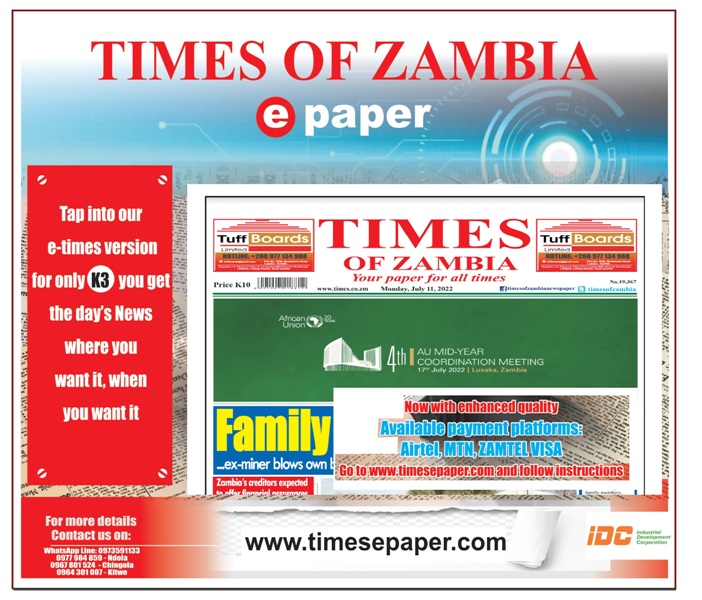 FIBRE To The Home (FTTH) service launched last week by the CEC Liquid Telecommunications Limited (CEC Liquid Telecom) targets 20,000 homes and businesses of all sizes that want to access superfast broadband with unlimited data packages.
FIBRE To The Home (FTTH) service launched last week by the CEC Liquid Telecommunications Limited (CEC Liquid Telecom) targets 20,000 homes and businesses of all sizes that want to access superfast broadband with unlimited data packages.
In a CEC Liquid Telecom press release, FTTH Service will provide speeds of up to 100 Mega bite per second (Mbps), the fastest broadband ever available in Zambia. It will provide Zambians with the Real Internet enabling businesses to use cloud-based services such as Microsoft 365, Dropbox and online backups; as well as video conferencing based on OTT services, like Skype.
For home users, the FTTH service enables the whole family to be online at once using multiple devices.
Fibre Optic technology has taken off with laying of fibrebeing done by both the government and the private sector. Industry leaders laying cables include Copperbelt Energy Corporation (CEC), Zambia Electricity Supply Company(ZESCO), Zambia Telecommunication Communications Company, Zamtel and Liquid Telecom. ZESCO laid fibre on the electricity pole lines.
The economic potential from easily accessible broadband connectivity is nearly endless, but the duplication of fibre cables is really a waste of time and resources. There is need for all optic fibre players to work in collaboration to stimulate delivery and to drive demand.
Private sector and Government need to work much closer together to create a framework which deploys complementarity, rather than un serviced areas. From my observation there is no collaboration as duplication of laying cables continues to be an issue that has not been resolved.
Having shared infrastructure on fibre could avoid costly duplication and could serve as a solution for these problems. There is needto make informed decisions for planning fiber optic networks and avoiding unnecessary duplication. Finding already laid fibre can save cities a lot of money in initial installation costs. It is better for Industry leaders to analyse fibre infrastructure of an area so that they can decide how best to utilize it in order to enhance high speed internet access and to meet the growing connectivity demands.
The FTTH service is initially available to around 8,000 homes and businesses in Lusaka including the areas of Rhodes Park, Northmead, Long Acres, Sunningdale and Kabulonga.
It is being sold to end-users through ISPs which are authorised CEC Liquid Telecom Resellers.
This year, CEC Liquid Telecom will invest around US$15 million in the FTTH build, which will continue indefinitely and is expected to reach 20,000 premises in Lusaka by year-end. Services will become available as each targeted area is connected with a likelihood that the build will extend to Copperbelt towns by the end of the year.
An initial pilot project last year received extremely positive feedback from customers who were impressed with both the speed and reliability.
Andrew Kapula, CEC Liquid Telecom Managing Director, said “This is a major milestone in the development of Zambia’s telecoms infrastructure. We believe in the power of connectivity to change lives and will continue to invest in building a high-quality network which will enable our people and businesses to prosper.”
Kapula said CEC Liquid Telecom’s hence positions itself as the country’s most reliable and consistent broadband provider. Last month, the company announced a US$5 million investment in building a new fibre link between Lusaka and Livingstone to provide both retail and wholesale customers with the most reliable, high-speed broadband connectivity in Southern Zambia.
Nic Rudnick said: “Our FTTH service has made accessing streamed, high-definition media via the Internet a reality for homes and small businesses in some of the remotest parts of Africa. As a household or business in Africa, you cannot really benefit from global Internet services unless you have a high-speed fibre connection in addition to a mobile device.
Rudnick said for FTTH to work in Africa there was need for International connectivity at a reasonable price – provided by subsea cables, Terrestrial backbone networks bringing capacity inland, Fibre rings around and the Gigabit PON (GPON) FTTH technology.
An IT Head at Joma Tech ICT Solutions JohnTshnseki connected to fibre said it was good as having a cable connected to the service provider and theand the other connected to the user node. He however bemoaned the fact that road rehabilitation and others that involve digging the ground temper with cables and break the communication.
Tshnseki said fibre was expensive with distance if one’s location was miles away from the nearest pop. “You will pay more as it is charged per km.
He explained that for one of his clients based in Roma, they had to pay K2500 per km in terms of last mile connectivity. He said they paid K10 000 for a distance of 4km and have a monthly plan of K5600.
As we welcome this service in our neighbourhood, it would be nice to know if CEC Liquid will also provide the infrastructure and hence last mile connectivity. Last-mile technology is any telecommunications technology that carries signals from the broad telecommunication backbone along the relatively short distance to and from the home or business.
In many communities, last-mile technology represents a major remaining challenge because the cost of providing high-speed, high-bandwidth services to individual subscribers in remote areas can be higher than the service provider would like. Laying fiber optic cables is an expensive undertaking that can be environmentally demanding and require high maintenance. Experts hope that broadband wireless networks will eventually provide the solution and meet everyone’s needs.
CEC Liquid Telecom is a joint venture between The Liquid Telecom Group and Copperbelt Energy Corporation PLC (CEC), a Zambian power generation, transmission and distribution company. Its nationwide fibre network is the first fully-redundant network in Zambia, providing SLAs at a level not previously experienced in the country.
International access is through the multi-award-winning pan-African fibre and satellite networks of The Liquid Telecom Group, which connect to five different sea cables – WACS, EASSY, SEACOM, SAT3 and TEAMs.
CEC Liquid Telecom provides IP Transit, MPLS, backhaul, disaster recovery and data protection services to a wide variety of customers: businesses of all sizes including financial institutions and tourism-related companies, Government and education institutions as well as operators and ISPs.
Ten years ago, we used to write that Zambia was going to benefit from a drastic reduction of telecommunication cost when optic fibre becomes a reality.It now clear that the country needs infrasture to be able to realise the benefits of the fibre optic cable.
Until recently most of Zambia’s service providers have been using Satellite technology and that this has been very expensive since the service providers had to pay a lot of money to foreign couriers.With broadband the price is expected to be cheaper and the platform used for so many things. As a consumer the benefits are many and broadband is the answer. What cheap rate are we expecting from the FTTH plan?
For many ISPs connectivity of internet was through VSAT to Europe and even to neighboring countries which made the cost to be very expensive. The quality of service they used to get was not very good compared to fibre.
The completion of the fiber optic project will benefit services that require real time such as Video, Voice and data. Individuals and businesses in the Zambia would benefit from high speeds at affordable costs as optic fibre brings with it unprecedented opportunities for both commercial growth and socio-economic expansion throughout the continent.
Broadband connectivity to all parts of Africa is a prerequisite for the successful proliferation of e-commerce, Internet, and other broadband applications and projects on the continent.
The Zambia Telecommunication Company (ZAMTEL) developments laying Optic fibre in the Metropolitan City of Lusaka will help to reduce the cost of using satellite.
The National ICT Policy notes that in order to leapfrog the existing capacity and technology requirements for overhauling the existing telecommunications infrastructure, thereby laying a solid foundation for delivering current and future services ranging from digital Radio, Television, Internet, data and other multimedia services.
Fibre based Technology provides a comprehensive and reliable network for the country. The possibility of reducing telephone and internet costs can be achieved by interconnecting the proposed national Fibre Optic Network to the undersea cable running along the African coast connecting to Europe and Asia, some of the most active destinations for Zambia.
Zambia has in the recent past seen utility companies such as the Zambia Electricity Company (ZESCO) and the Copperbelt Energy Corporation (CEC) lay and commission the installation of optic fibre in their system to provide quality service.
Liquid Telecom is the leading independent data, voice and IP provider in Eastern, Central and Southern Africa. It supplies fibre optic, satellite and international carrier services to Africa’s largest mobile network operators, ISPs, financial institutions and businesses of all sizes.
Liquid Telecom has built Africa’s largest single fibre network which runs from the north of Uganda to Cape Town, currently spanning over 18,000km across borders and covering Africa’s fastest-growing economies where no fixed network has existed before.
Liquid Telecom’s network provides connectivity onto the five main subsea cable systems landing in Africa; WACS, EASSY, SEACOM, SAT3 and TEAMs.
The Copperbelt Energy Corporation PLC (CEC) is an independent power generation, transmission and distribution company, with interests in closely linked businesses in Zambia and the Sub-Saharan African region, including optic fibre based telecommunications. A member of the Southern African Power Pool and listed on the Lusaka Stock Exchange, CEC has operations and projects in development in Zambia, Nigeria, Sierra Leone and Namibia.






